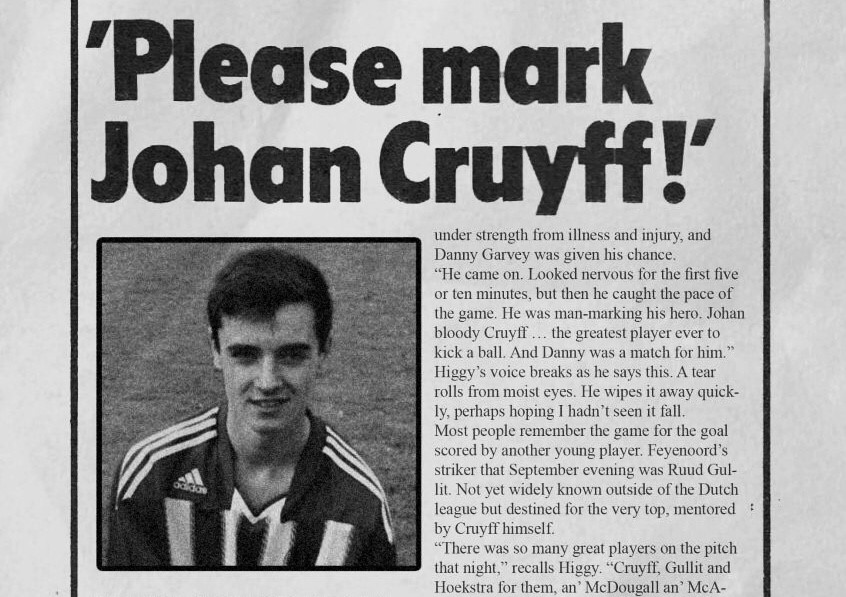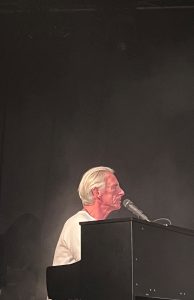When Danny Garvey Man-Marked Johan Cruyff
“We didn’t know it then obviously, but that was the pinnacle for him. only months later, and the injury …” Peter Higgins tails off. He looks away and slowly shakes his head. The rawness of this 37-year-old memory still prompts pride and regret in equal measure. Peter – or ‘Higgy’ as he has been known for most of his ninety years – is still razor sharp in his command of statistics that relate to Barshaw Bridge FC. He is speaking to me on the eve of the Ayrshire Junior Club’s 150-year anniversary. A new museum is opening, commemorating the club’s turbulent history and the subsequent careers of notable former players such as Bill Shankly, Jock Reid, and more recently, Danny Garvey. And it’s Garvey – Higgy’s nephew – who is firmly on his mind today as we sit on the edge of the Barn looking out over newly laid turf. The surface may not have seen action for over a year due to the pandemic, but the ghosts of Garvey goals past are as vivid for Higgy today as they ever were.
“I can still see him, clear as day,” says Higgy, a smile breaking. “Not yet 16 and running rings around fat midfielders. He was in total control on this pitch. No hiding here. Calm and focused, he was. An old head on young shoulders, just like his hero.” The hero Higgy is referring to was the maestro of total football, Johan Cruyff.
In August 1983, Danny Garvey was excelling in the Aberdeen youth team having signed for the EUFA Cup holders earlier in the year. Keen to get the young midfielder more competitive football, Dons manager Alex Ferguson put him out on loan to St. Mirren, his former club. Showing the same promise as he had in the north-east, Garvey immediately made a few first-team appearances from the bench.
“Up at Aberdeen, they were trying to turn him into a right back,” says Higgy, his shaking head indicating the folly of this. “He had vision and strength and real ability. Danny could make things happen on the pitch. Despite his age, the lads at St Mirren could see that, and played him in the right position.” Garvey scored in a match against St Johnstone and found himself in the squad for the next game, the visit of Dutch cracks, Feyenoord in an early round of the UEFA Cup.
Often the forgotten team of the Dutch Eredivisie, the Rotterdam club had the 37-year-old Dutch master, Johan Cruyff in its ranks. Cruyff had shocked European football at the end of the 1983 campaign by leaving Ajax for their bitter rivals. After a reasonable good start to their season, Feyenoord arrived in Scotland smarting from an 8-2 mauling by the Champions in a bad-tempered battle in Amsterdam.
“Cruyff might’ve been at end of his playing career, but he was still lightning quick. Still had an eye for a pass that would cut a team open.”
Higgy admits that he sneaked in to Love Street that Wednesday evening. “Things with me and the boy and his brother … they weren’t good back then, you know? He didn’t want us there. But if he’d got on and I had missed it, I’d never have been able to live with that.”
Only twenty minutes into the match, and with the game evenly poised, Phil McAveety went off injured. The Paisley squad went into the match under strength from illness and injury, and Danny Garvey was given his chance.
“He came on. Looked nervous for the first five or ten minutes, but then he caught the pace of the game. He was man-marking his hero. Johan bloody Cruyff … the greatest player ever to kick a ball. And Danny was a match for him.” Higgy’s voice breaks as he says this. A tear rolls from moist eyes. He wipes it away quickly, perhaps hoping I hadn’t seen it fall.
Most people remember the game for the goal scored by another young player. Feyenoord’s striker that September evening was Ruud Gullit. Not yet widely known outside of the Dutch league but destined for the very top, mentored by Cruyff himself.
“There was so many great players on the pitch that night,” recalls Higgy. “Cruyff, Gullit and Hoekstra for them, an’ McDougall an’ McAvennie for the Buddies. But 16-year-old Danny Garvey didn’t look out of place amongst any of them.”
We walk along the lush, carpeted hallway of the small Barshaw Bridge museum. There are numerous photographs of the Barshaw Bridge team that won the Ayrshire Cup in 1997, but none of Garvey who had returned to the village as manager. Danny Garvey disappeared suddenly on the day of the Final. Before I enquire further, Higgy has ushered me on until we arrive at the framed red-and white shirt at the corner. It is signed, and the black scrawled message across it has been transcribed and engraved on metal plate:
‘Best wishes, Danny. You had me in your back pocket. The sky’s the limit for you.
Johan Cruyff. ‘83’
I ask Peter Higgins what he thinks became of Danny Garvey. He answers obliquely: “He could’ve been the greatest of them all. But the expectation was just too much for him.”
Higgy sighs one last time, before smiling ruefully. “Aye, there was only one Danny Garvey.”



